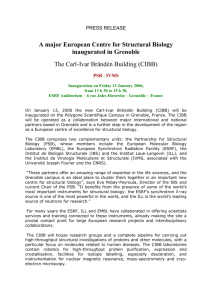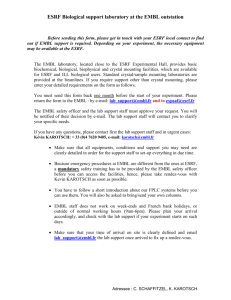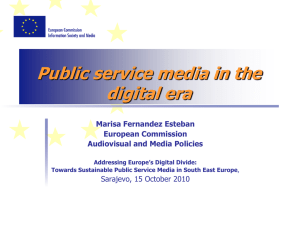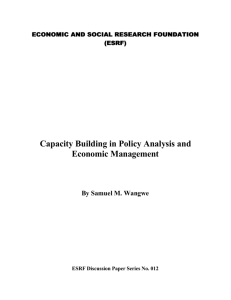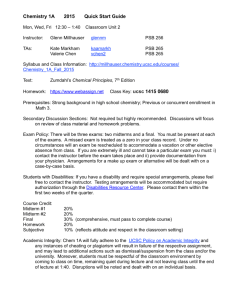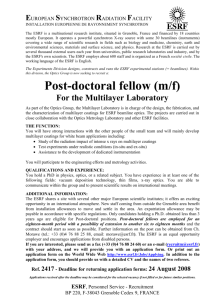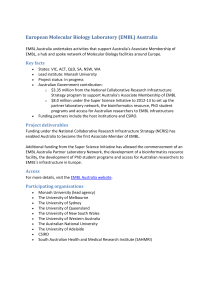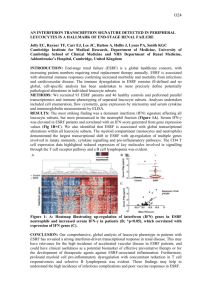PSB et al
advertisement
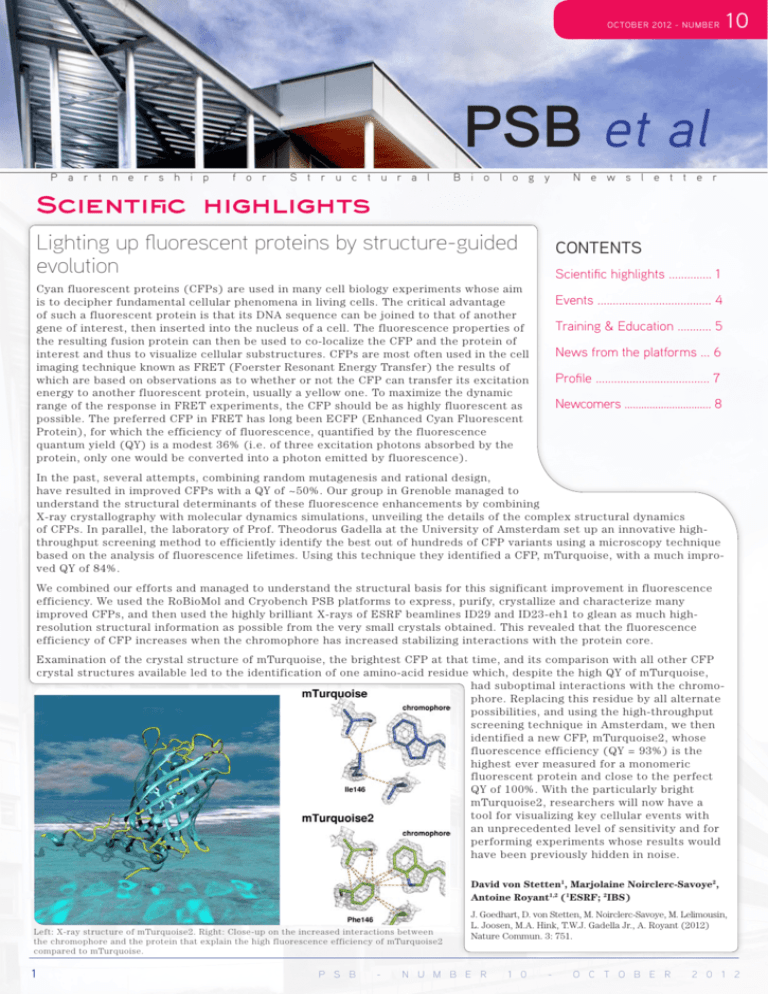
OCTOBER 2012 - NUMBER 10 PSB et al P a r t n e r s h i p f o r S t r u c t u r a l B i o l o g y N e w s l e t t e r Scientific highlights Lighting up fluorescent proteins by structure-guided evolution CONTENTS Scientific highlights .............. 1 Cyan fluorescent proteins (CFPs) are used in many cell biology experiments whose aim is to decipher fundamental cellular phenomena in living cells. The critical advantage of such a fluorescent protein is that its DNA sequence can be joined to that of another gene of interest, then inserted into the nucleus of a cell. The fluorescence properties of the resulting fusion protein can then be used to co-localize the CFP and the protein of interest and thus to visualize cellular substructures. CFPs are most often used in the cell imaging technique known as FRET (Foerster Resonant Energy Transfer) the results of which are based on observations as to whether or not the CFP can transfer its excitation energy to another fluorescent protein, usually a yellow one. To maximize the dynamic range of the response in FRET experiments, the CFP should be as highly fluorescent as possible. The preferred CFP in FRET has long been ECFP (Enhanced Cyan Fluorescent Protein), for which the efficiency of fluorescence, quantified by the fluorescence quantum yield (QY) is a modest 36% (i.e. of three excitation photons absorbed by the protein, only one would be converted into a photon emitted by fluorescence). Events ..................................... 4 Training & Education ........... 5 News from the platforms ... 6 Profile ..................................... 7 Newcomers ............................... 8 In the past, several attempts, combining random mutagenesis and rational design, have resulted in improved CFPs with a QY of ~50%. Our group in Grenoble managed to understand the structural determinants of these fluorescence enhancements by combining X-ray crystallography with molecular dynamics simulations, unveiling the details of the complex structural dynamics of CFPs. In parallel, the laboratory of Prof. Theodorus Gadella at the University of Amsterdam set up an innovative highthroughput screening method to efficiently identify the best out of hundreds of CFP variants using a microscopy technique based on the analysis of fluorescence lifetimes. Using this technique they identified a CFP, mTurquoise, with a much improved QY of 84%. We combined our efforts and managed to understand the structural basis for this significant improvement in fluorescence efficiency. We used the RoBioMol and Cryobench PSB platforms to express, purify, crystallize and characterize many improved CFPs, and then used the highly brilliant X-rays of ESRF beamlines ID29 and ID23-eh1 to glean as much highresolution structural information as possible from the very small crystals obtained. This revealed that the fluorescence efficiency of CFP increases when the chromophore has increased stabilizing interactions with the protein core. Examination of the crystal structure of mTurquoise, the brightest CFP at that time, and its comparison with all other CFP crystal structures available led to the identification of one amino-acid residue which, despite the high QY of mTurquoise, had suboptimal interactions with the chromophore. Replacing this residue by all alternate possibilities, and using the high-throughput screening technique in Amsterdam, we then identified a new CFP, mTurquoise2, whose fluorescence efficiency (QY = 93%) is the highest ever measured for a monomeric fluorescent protein and close to the perfect QY of 100%. With the particularly bright mTurquoise2, researchers will now have a tool for visualizing key cellular events with an unprecedented level of sensitivity and for performing experiments whose results would have been previously hidden in noise. David von Stetten1, Marjolaine Noirclerc-Savoye2, Antoine Royant1,2 (1ESRF; 2IBS) Left: X-ray structure of mTurquoise2. Right: Close-up on the increased interactions between the chromophore and the protein that explain the high fluorescence efficiency of mTurquoise2 compared to mTurquoise. 1 P S B - J. Goedhart, D. von Stetten, M. Noirclerc-Savoye, M. Lelimousin, L. Joosen, M.A. Hink, T.W.J. Gadella Jr., A. Royant (2012) Nature Commun. 3: 751. N U M B E R 1 0 - O C T O B E R 2 0 1 2 No water needed for function - Dynamics of solvent-free myoglobin Forces that stabilize protein structures and allow biological function are intimately linked with the ubiquitous aqueous environment of living systems. Consequently, biomolecular activity is highly sensitive to the interplay of water–protein interactions. However, it has been observed that proteins can even fold into native-like structures in non-aqueous media. This might be due to a few well-ordered hydrationlayer water molecules remaining associated to the protein surface in non-aqueous media: Enzymes at very low hydration levels, both in gas and in organic solvents sometimes still display biological activity [1]. Recently, Adam Perriman and Steve Mann (University of Bristol, United Kingdom) were able to go further and produce the first solvent-free protein liquid, a system composed of a protein molecule, functionalized to host a polymer-based corona encapsulating the protein. The generation of room-temperature solventfree myoglobin liquids with retained function presents novel challenges to existing theories on the role of solvent molecules in structural biology, and offers new opportunities in protein-based nanoscience and bionanotechnology [2]. The observation of biological activity in solvent-free protein polymer hybrids challenges the view of aqueous and non-aqueous solvents being unique promoters of protein dynamics linked to function. Incoherent neutron scattering (INS) is widely Myoglobin (red) exhibits biologically relevant dynamics, even when its hydration sphere is replaced by a polymer surfactant corona (grey). used to study protein dynamics and probes atomic motions on the ns−ps time- and Å length-scales. In a recently published paper [3] by Gallat and co-workers (an international collaboration between the University of Bristol, the Australian National University (Canberra), the Jülich Center for Neutron Science (JCNS) at FRM II (Garching, Germany), the ILL, the IBS and the ILL-EMBL Deuteration Lab) elastic incoherent neutron scattering (EINS) combined with specific deuterium labelling was used for the first time to separately study protein and polymer motions in solvent-free hybrids (See figure). Temperature-dependent atomic mean square displacements (MSD) of the polymer and protein motions were measured separately, after having deuterated either the protein or the polymer moiety within the hybrid, respectively. EINS experiments were carried out on the backscattering spectrometers IN16 (ILL) and SPHERES (JCNS at FRMII). The large-scale production of perdeuterated myoglobin sample was achieved in the ILL-EMBL Deuteration-Laboratory using high cell density fermenter cultures. Myoglobin motions within the hybrid are found to closely resemble those of a hydrated protein, and motions of the polymer coating are similar to those of the hydration water, leading to the conclusion that the polymer coating plasticizes protein structures in a way similar to hydration water [3]. Biologically active nano-hybrids find applications ranging from biosensor development to electrochemical reduction of CO 2 to produce liquid fuels. Their use in the development of new wound dressings can also reduce healing time: the liquid protein could be applied either internally or externally to the wound by supplying oxygen or other essential chemicals to the damaged tissue. F.X. Gallat 1, 2, M. Härtlein 1, M. Moulin 1 and M. Weik 2 ( 1 ILL, 2 IBS) [1] M. Lopez, V. Kurkal-Siebert, R.V. Dunn, M. Tehei et al. (2010). Biophys. 99: L62-64. [2] A. Perriman, A. Brogan, H. Cölfen, N. Tsoureas et al. (2010). Nature Chemistry 2(8), 622-6. [3] F.-G. Gallat, A. Brogan, Y. Fichou, N. McGrath et al. (2012). J. Am. Chem. Soc.; DOI, 10.1021/ja303894g Adenovirus pseudoparticle function unravelled Adenoviruses are DNA viruses responsible of mainly pharagintisis and conjunctivitis. The 60 serotypes affecting humans produce an excess of capsid proteins during their replication compared to the protein needed for progeny virions encapsidation. Interestingly, in some serotypes including Adenovirus of serotype 3 (Ad3), the two capsid proteins involved in cell internalization (penton base and fibre) and located at the twelve vertices of the icosahedral shell, auto-assemble symmetrically to give a viral like particle (VLP). This particle has been named “adenovirus dodecahedron” (Ad-Dd; from the greek δϖδεκα= twelve). To our knowledge, this is a unique case of VLP made of viral proteins that normally do not interact together in the viral capsid (see figure). In the past, we have investigated several aspects of this amazing particle but the biological function of this VLP during the viral replication cycle was unknown. The use of Ad-Dd as a bait allowed the recent identification of the Ad3 receptor by Dr Lieber’s group in Seattle (USA) in collaboration with us [1]. Desmoglein 2 (DSG-2), a component of desmosomal junctions between epithelial cells, has been reported to interact with high affinity (Kd= 2nM) to both Ad3 and Ad-Dd. This discovery enabled us to draw hypothesis on the putative functions for Ad-Dd. We then 2 P S B - N U M B E R 1 0 - O C T O B E R 2 0 1 2 launched a collaborative work with Pr Blair’s group at the University of Leeds (UK) and designed different cellular experiments, playing with both Ad-Dd and Ad3 fused to the green fluorescent protein (GFP) as a marker. In a first set of experiments using cytometry analysis, we showed that Ad-Dd competed with Ad3 for DSG-2 binding and could almost totally abolish the viral entry. We have then demonstrated that this competition resulted from two complementary effects: receptor occupancy by Ad-Dd but also receptor endocytosis by this virus like particle. In a further experiment combining biophysical methods and confocal microscopy we also demonstrated that fibre binding to DSG-2 triggered cell remodeling but only in a dodecameric constellation as isolated fibre cannot produce this effect. This mechanism - called epithelial to mesenchymal transition (EMT) - dedifferenciates epithelial cells leading, in particular, to a change in receptor distribution at the cell surface. Altogether we conclude from these data that Ad-Dd produced in excess compare to Ad3 during the viral replication cycle acts both as a competitor for the progeny virion but also as a “cell remodeler”. One can imagine that when a first cell is infected in a tissue by Ad3, the excess of Ad-Dd released with Top panel: Micrographs of Adenovirus with fibre protruding outside (depicted by arrows) and adenovirus dodethe progeny virions both prevents direct cahedron (bar: 100nm). Right panel: Immunofluorecence pictures of Hela Cell incubated (bottom) or not (top) with dodecahedron for one hour. Nuclei are counterstained in blue, actin in green and dodecahedron in purple. recapture of virions by the neighboring Left bottom panel: Schematic representation showing a first cell infected by adenovirus (in red), after viral cells and also change the cell cohesion at replication, dodecahedron (in orange) are produced in excess compared to progeny virions (in red). Dodecavicinity of the first infected cell leading to hedron competes with Ad3 by: (1) occupying DSG-2 receptor (flash symbol) and (2) triggering its endocytosis but also remodels the cell (3) making access to receptors far away from the initial site of infection for the a deeper infection by Ad3. This strategy progeny virions. retained by evolution is really intriguing as the icosahedral virus produces a dodecahedral viral pseudoparticle as a lure [2]. Moreover, from a geometric point of view, icosahedron and dodecahedron both belongs to the platonic solids and are the dual of each other (20 facets, 12 edges and 12 facets, 20 edges respectively). We acknowledge the PSB electron microscopy and cellular imagery platforms for access to the instruments. P. Fender 1 & G. Schoehn 1,2 ( 1 UVHCI, 2IBS) [1] Wang et al., Nature Medicine 2011; 17(1): 96-104 [2] Fender P, Hall K, Schoehn G and Blair GE. Journal of Virology 2012; 86(11): 6286-302 How viral RNA is detected by the innate immune receptor RIG-I The innate immune system is an ancient surveillance and response mechanism that provides an immediate defense against pathogen infection until an adaptive immune response can be established. The first step in innate immunity involves the recognition of nonself microbe-associated molecular patterns that don’t normally exist in an uninfected cell, such as the 5′-triphosphate base-paired RNA (5′pppbpRNA) generated by many viral RNA-dependent RNA polymerases, including influenza. Diverse pattern recognition receptors (PRRs) exist, one of which is the intracellular retinoic acid-inducible gene 1 (RIG-I). RIG-I is a large (106 kDa), vertebrate conserved, superfamily 2 (SF2) helicase (Figure a) that upon detection of 5′ppp-bpRNA of viral origin induces a signaling cascade resulting in upregulation of type 1 interferons and establishment of an antiviral state. However, the molecular mechanism underlying RIG-I activation was largely unknown until recently. Stephen Cusack’s group has been studying RNA interacting proteins for many years and Eva Kowalinski, a EMBL PhD student, and colleagues determined the structure of several duck RIG-I constructs of various lengths, including one with a 19-mer dsRNA bound (Figure b and c). Interestingly, the complex structure revealed that RIG-I completely surrounds the dsRNA and interacts with the RNA backbone from both chains, providing valuable insights on how other important members of the SF2 helicase family, such as DICER, can interact with RNA. Taken together the six individual structures, published in Cell, enabled the authors to visualize the elegant conformational change that occurs when RIG-I recognises viral RNA thus triggering downstream signaling. In the repressed state, the tandem CARD domains, known to be important for signaling, associate with the helicase region. RIG-I activation first involves the capture of the 5′ppp-bpRNA by the C-terminal domain, which is followed by the co-operative binding of ATP and dsRNA to the helicase domain. This high affinity ATP/dsRNA conformation results in the release of the CARD domains for downstream signaling and interferon production (see Figure). These remarkable results, which were validated using cell based assays (collaboration with D. Gerlier’s group at INSERM, Lyon), rationally explain the wealth of data currently available on RIG-I signaling. Further studies are continuing on the downstream signaling and on other members of this PRR family. P S B - N U M B E R 1 0 - O C T O B E R 2 0 1 2 3 The research environment provided by the PSB was critical to the success of the project. Many of the PSB platforms were used but most notably the eukaryotic expression facility, the HTX platform, the biophysical platform and the massspectroscopy facility. In addition, regular access to the highly automated EMBL/ESRF joint structural biology beamlines for the screening of nearly 600 crystals and the collection of over 100 datasets was essential for the success of the project. From molecular mechanisms to integrated life processes SFBBM-SFB 2012 congress 21-23 November 2012, Grenoble, France This conference is organized by the SFBBM and the SFB, in partnership with the thematic groups Archaea, Biostruc, GGMM (modelling), the SFPb, and the Labex Grenoble, Alliance for Integrated Structural and Cellular Biology. Understanding the processes supporting life is now served by recent advances allowing to bridge the gap between the study of individual molecules and the understanding of their functioning in a cellular context. The SFBBM-SFB 2012 congress will bring together about 300 scientists interested in innovative methodologies to understand key cellular processes. Kowalinski, E.1,2, Lunardi, T.1,2, McCarthy, A. A.1,2, Louber, J.3, Brunel, J.3, Grigorov, B.3, Gerlier, D.3, and Cusack S.1,2 (2011) Cell, 147, 423-435. Thirteen sessions will be organized with three keynote speakers, Jules Hoffmann, Ernst Bamberg and Carlos Bustamante. About 50 oral presentations will be selected among the participants from submitted abstracts. Five poster sessions are planned, and about ten poster prizes will be attributed. http://sfbbm-sfb2012.org EMBL-Grenoble 2UVHCI 3Human Virology, INSERM U758, ENS Lyon, Université Lyon 1, 21 Avenue Tony Garnier, 69007 Lyon, France. 1 Training Events & Education EMBO Course: Learning about complexes Twenty young scientists representing eighteen different nationalities spent a week at the PSB last June learning how to deal with challenging problems in structural biology. The group of 12 Ph.D. students and 8 postdocs came to Grenoble to take part in the EMBO Practical Course on the Structural Characterization of Macromolecular Complexes, an event organized biennially at the PSB since 2002. Co-sponsored by P-CUBE, BioStructX, Instruct and the ESRF, the EMBO course taught participants how to expedite structural biology projects involving macromolecular complexes by exploiting a wide diversity of experimental approaches. During the week participants learned how to produce, purify and reconstitute complexes, analyze macromolecular interactions biophysically, and characterize complexes using synchrotron-associated methods (crystallography and small-angle scattering) as well as complementary techniques such as electron microscopy, NMR and mass spectrometry. Activation of RIG-I by 5'ppp-bpRNA and ATP binding. (a) Colour-coded domain structure of RIG-I (b) Model of the auto-repressed state of duck RIG-I. The flexibly-linked CTD (invisible in the crystal structure) is included to illustrate that it is free to detect and bind with high affinity 5'ppp-bpRNA as the first step in activation. The tandem CARDs, bound via CARD2 to Hel-2i, are unavailable for signalling in this state. (c) Model of the ATP and RNA bound activated state of duck RIG-I with added CARDs on a 55-residue long flexible linker. In (b) and (c) the Hel-2i domains (yellow) are superposed to show that CARD2 binding to Hel-2i is incompatible with the bound position of the RNA and CTD. Teaching the course were 21 speakers from across Europe and North America, including several P-CUBE partners and local scientists. They lectured on topics that covered both "tactical" and "strategic" aspects of structural projects involving macromolecular complexes. These morning seminars were complemented by afternoon practical sessions run by local tutors, allowing participants to gain hands-on experience with techniques and instruments presented during the lectures. Among other things, participants prepared sample grids for electron microscopy, monitored a protein-protein interaction by NMR, collected SAXS and MX data at ESRF beamlines, determined binding constants by microscale thermophoresis, and optimized protein buffer conditions in a thermofluor stability assay. Several participants brought their own samples which they could characterize during these practicals. Events The 2012 PSB Students’ Day Held on the 30th January, at the ILL Chadwick Amphitheatre, the PSB Students’ Day attracted numerous participants, ranging from students to senior scientists. In the opening seminar, Chloe Zubieta (ESRF) shared her story on achieving a group leader position, step by step after graduate school. Then, Julien Perard (CNRS) introduced the PSB Biophysical Platform. Carlo Petosa (IBS) Photo: Serge Claisse Eric Thierry (UVHCI) & Yan Nie (EMBL), on behalf of the PSB student committee Course details and lecture notes are available at http://www.embl.fr/embo2012/ Photo: Serge Claisse After the opening talks, Eric Thierry (UVHCI), Erika Pellegrini (ESRF), François-Xavier Gallat (ILL), Mathieu Botte (EMBL), and Bridgette Connell (IBS) discussed their most recent research achievements. 26 first-year PhD students also introduced their thesis projects during a clip session. Further research results were presented in poster sessions during the buffet lunch and coffee break, in the ILL Entrance Hallway. The last seminar was given by a former PSB PhD student, Alexandre Dias, who now works at Diamond Light Source as an Industrial Liaison Scientist. His talk was especially inspiring for students considering a transition from academia to industry after graduation. At the closing ceremony Qiyang Jiang (EMBL) was awarded the Best Clip Prize and Manuel Blanc (ILL) the Best Poster Prize. Reaction to the course has been highly positive. "The course was really useful," said one participant. "I learned a lot of information and am looking forward to applying these techniques in my own research. The week overall was a wonderfully enriching experience." Another wrote, "The majority of speakers really engaged in talking to us and discussing our projects and trying to find ways to improve them. I've profited much more from them than just by listening to their lectures. I think everybody learned a lot and will now go back to the lab with a lot of new ideas. Thanks and congratulations to all the organizers, speakers and tutors involved." Participants of the EMBO course on Macromolecular Complexes. 4 P S B - N U M B E R 1 0 - O C T O B E R 2 0 1 2 P S B - N U M B E R 1 0 - O C T O B E R 2 0 1 2 5 Profile First COSMX Training Course Giuseppe Zaccai Photo: Chantal Argoud The first edition of a training in complementary optical spectroscopies in macromolecular crystallography (COSMX) was held in Grenoble from Sep. 19-21. It was organized by ESRF, IBS and EMBL, in collaboration with the Swiss Light Source and Diamond. Financial support was provided by BioStruct-X and the ESRF. The first day was dedicated to courses on the various instruments, techniques and methods available on structural biology beamlines at all three synchrotrons. Practicals were held during the second day on beamlines. Participants were encouraged to bring samples from their own research projects. The final half-day was devoted to application examples and a wrap-up discussion. A total of 18 participants, PhD students, post-docs and young scientists, from 8 different countries, attended lectures given by a total of 13 tutors on the manifold aspects of optical spectroscopies applied to macromolecular crystals. Practicals on beamlines ID14-EH1 (online UV-vis absorption microspec), ID23-EH2 (UV-RIP) and ID29 (online Raman) and at the Cryobench (ID29S – offline UV-vis absorption and fluorescence microspec) were supervised by staff from the ESRF, IBS, EMBL and SLS, using state-of-the-art in-house-conceived instrumentation. Feedback from participants was highly enthusiastic. Most of them were able to record good-quality spectra out of their samples, which promotes the use of complementary optical spectroscopy in crystallo and should result in new experimental proposals at the ESRF and other synchrotrons. Daniele de Sanctis1, Max Nanao2, Antoine Royant1,3 ESRF, 2EMBL Grenoble Outstation, 3IBS 1 News from the platforms Unité Mixte de Service Darren Hart (EMBL) has been appointed as the director of the new Unité Mixte de Service (UMS), a joint venture by the CNRS, CEA, UJF and EMBL to organise the IBS and UVHCI technical platforms for access by local, national, industrial and international users. He is assisted by Yvette Gaude, the UMS financial administrator who has many years of experience in similar projects, most recently at the CNRS. The UMS was established following the award of 10.5 M€ to Grenoble as part of the French Infrastructure for Integrated Structural Biology (FRISBI), financed by the “Investissement pour l’Avenir” program. This money is funding major upgrades to many of the platforms in the PSB, including the purchase of new NMR spectrometers and electron microscopes at the IBS. The overall aims of the UMS are to ensure sustainable platform operations and demonstrate that Grenoble can provide well-organised access to local and external users. In this way, it is hoped to secure further infrastructure funding under Horizon 2020 (the new EC funding mechanism) where European structural biology infrastructures are currently organising themselves according to the Instruct plan for a Europe-wide “distributed infrastructure”; in France, Grenoble and Strasbourg form two core centres with three further centres of excellence (Montpellier, Marseille, South-Paris). D. Hart (EMBL) Giuseppe Zaccai is also known at the ILL and elsewhere as Joe. You can often spot him under a panama-like hat at the EPN campus, where he feels privileged to meet a variety of people and subjects beyond Science. The internationality comes naturally, as do the 5 languages Joe learned relatively early on in his life. Joe was born in Egypt to an Italian father and a Greek mother. Before coming to live in France, he obtained his PhD in Physics at the University of Edinburgh (1972) and was a Postdoctoral fellow at the Brookhaven National Laboratory in New York. Joe is Research Director at the CNRS and was Head of the Laboratory of Molecular Biophysics at the IBS. When asked about what makes a work-place interesting, Joe was clear: “If restarting my career now I would try to work in a place like the EPN campus, where I can talk to people from different backgrounds.” The cultural dimension (scientific and otherwise) clearly sets the scenario for questions such as: how soft is a protein? [1] Given his appreciation for holistic views, Joe was challenged to expand his experience on dynamics and conformational flexibility to a concern of every scientist: how flexible should a researcher be? “That is a very difficult question, because it is obvious that interdisciplinarity is essential. It is all about flexibility in the end. On the other hand, my experience tells me that being discipline focused and joining well-defined structures with clear limitations makes life easier. Young scientists can however become trapped between disciplines. It will be difficult to move on to a job/community that does not recognise you or your work. There are classic divides between disciplines, and to be able to cross these you will need the help of a Champion. For me it was Bernard Jacrot, an established physicist who ventured into the world of Biology and became highly respected across disciplines. It was thanks to Bernard that my interdisciplinarity work was understood and supported. This put me in an extremely privileged position where, despite never being successful in a research grant application, I had strong collaborations and the conditions to carry on research on what genuinely interested me, with no pressure to change focus.” Joe’s previous work on dynamics of whole cells (see PSB Newsletter nr 4, or [2],[3]) highlights his interdisciplinary curiosity, from the physical chemistry of life at extreme conditions to exobiology. Surprisingly, the following question met an almost reductionist answer: what led to this idea of approaching entire cells? “There is a constant discussion on the relevance of global versus site specific dynamics, again fed by well defined communities and related techniques. There are arguments to both sides of the discussion, even for the simple case of a single isolated protein. Regardless of the approach, it was clear to me that dynamics studies were essential but obtaining 100mgs of a pure protein is scary for a molecular biologist. 1g of whole cells, on the other hand, is almost too small to weigh. So my approach was mostly motivated by practical considerations. I did not know what the result of these studies would be. This was clearly a problem too complex to simply solve, but one can do comparisons between forces, flexibility and activity in different conditions. This led to an important conclusion on thermostability and flexibility, equally important for protein activity.” What was it like to collaborate with your own son in writing a book? “We found an unexpected common ground! Nathan and I have different views on many things, but our approach to writing of this book was very similar and I was pleased to feel we truly agreed. We encouraged each other a lot.” Do you feel you influenced your son in the choice of career? “Not intentionally. My family was obviously exposed to the life of a scientist through conferences, discussions at home, collaborations, etc. Nathan was the one who enjoyed it the most and decided independently that this was a path for him too." MASSIF MASSIF (Massively Automated Sample Selection Integrated Facility) will be a unique resource for macromolecular crystallography experiments based on second-generation automation. It is designed to help Structural Biologists to tackle ever more ambitious projects, such as protein complexes, membrane proteins and others. MASSIF will be the hub of all Structural Biology beam lines at the ESRF dedicated to sample evaluation. Such screening is vital to cope for example with the problem of inter- and intra-sample. After a sorting step, crystals will then be distributed to the best suited of seven end stations (MASSIF-1/-2/-3, ID23-1/-2, ID29 or ID30B) for diffraction data collection. MASSIF-1 will have the capability to screen crystals in a variety of mounts such as crystallisation plates and micro-fluidic chips. Automation will allow each of the stations to screen the diffraction characteristics of up to 1000 crystals per day. In addition, macromolecular crystals evaluation can be further complemented using the micro-spectroscopy facility (ID29S cryobench facility) which will be linked to MASSIF-1 for online experiments. Several spectroscopic techniques are currently available (UV/Vis, fluorescence, Raman spectroscopy) to characterize the functional state of a protein in its crystalline state, the monitoring of X-ray induced processes or the execution of elaborate kinetic crystallography experiments. First user operation of the MASSIF stations is expected in 2nd half 2013. What are your plans for retirement? “I hope to become an Emeritus Professor at the CNRS and to continue research at a relaxed pace. I always felt I do science because I want to, and this is true even now when I come to the ILL for an experiment at 4am. I enjoy my work so it is difficult for me to imagine it will become more relaxed after retirement"! Joe is now one of our Champions of course. It is obvious that his contributions to Science are far from over. Joe will continue to travel the world, absorbing experiences and collecting stories that are always a pleasure to listen to. Perhaps we will get a chance to read some of them, writing is one of his many passions. Susana Teixeira (ILL/Keele University) Within the upgrade programme, the bioSAXS facility formally located at the ID14-3 end station has been rebuild at the BM29 slot. User operation began in June 2012. Current work now focuses on improving the experimental environment with the incorporation of an online HPLC device, extension of automation, quality control and feedback for users. [1] Zaccai, G. (2000). Science, Vol. 288 no. 5471 pp. 1604-1607. [2] M. Jasnin, Moulin, M., Haertlein, M., Zaccai, G., Tehei, M. (2008). Biophys J. 95(2): 857–864. [3] Zaccai, G. (2010). Acta Cryst. D66, 1224–1228. See also the symposium in honour of Joe Zaccai's career http://www.ill.eu/news-events/events/sdds2012/ Christoph Mueller-Dieckmann (ESRF) 6 P S B - N U M B E R 1 0 - O C T O B E R 2 0 1 2 P S B - N U M B E R 1 0 - O C T O B E R 2 0 1 2 7 Newcomers Previously a Postdoc at the IBS, Anne Martel joined the Large Scale Structures group at the ILL to become Instrument co-responsible for the D22 instrument. Anne will be using Small Angle Neutron Scattering (SANS) to study solutions of biological macromolecules. For more information on future SANS studies or advice on beamtime applications: martela@ill.fr Joining us from PX’Therapeutics, Kevin Karotsch is now the new PSB Safety Officer. You can find him at the CIBB-S19 office or just drop him an email: karotsch@embl.fr Matthew Bowler has now moved to the EMBL where he will become part of the MASSIF project as the Beamline Scientist. Matthew can be contacted at: mbowler@embl.fr ESRF The Partnership for Structural Biology (PSB) is a collaboration between a number of prestigious European and French scientific laboratories in Grenoble which has received support from the EU FP6 programme. The PSB is unique in combining world leading user facilities for synchrotron X-ray and neutron scattering with NMR, electron microscopy, molecular biology and high throughput techniques on a single site together with strong projects in a broad range of structural biology, notably hostpathogen interactions. 8 Contacts Editors: Yan Nie (representing PSB PhD Students), Benoît Maillot (ESRF), Patricia Renesto (UVHCI) Editor-in-chief: Susana Teixeira (ILL) & Joanna Timmins (IBS) Layout: Virginie Guerard Email: cisbnewsletter@embl.fr www.psb-grenoble.eu P S B - N U M B E R 1 0 - O C T O B E R 2 0 1 2
